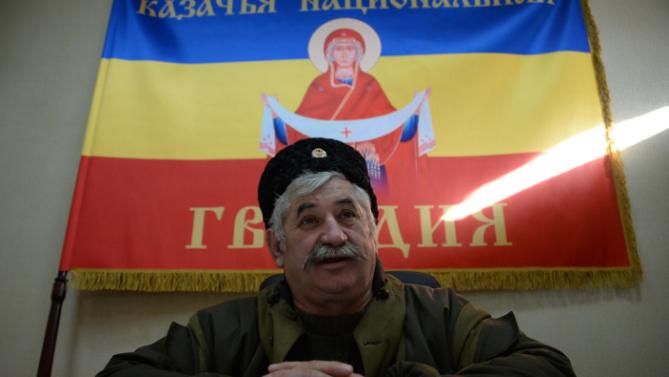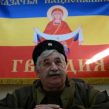
Armed Formations in the Secessionist ‘Luhansk Republic’ (Part Two)
Publication: Eurasia Daily Monitor Volume: 12 Issue: 9
By:

*To read Part One, please click here.
Russia is building secessionist proto-states on parts of Ukraine’s Donetsk and Luhansk provinces (collectively known as the Donbas region). This effort is advancing with relative ease in the “Donetsk People’s Republic” (DPR) but is faltering in the “Luhansk People’s Republic” (LPR) thus far.
The authorities claiming to represent the “LPR” actually control only Luhansk City and its vicinity. Autonomous armed formations, self-styled as Russian Cossacks, have divided up most of the “republic’s” territory, defying the “central” leadership. Each one of those formations is entrenched in a specific territory and loyal to its own “ataman” (leader). They rarely cooperate with Luhansk or even among themselves (see Part One in EDM, January 9, 2015).
Estimates of those formations’ manpower range from 8,000 to 17,000. Their combat tactics have nothing in common with the Cossack cavalry traditions. Instead, they use long-range artillery, tanks and armored vehicles, received (along with instructors) from Russia’s military during the active phase of hostilities against Ukraine.
Most of these self-styled Cossacks are (or were until very recently) affiliated with the “Cossack National Guard,” an offshoot of the All-Mighty (Vsevelikoye) Don Cossack Host, based across the border in Russia’s Rostov oblast. Led by Ataman Nikolai Kozitsyn, this National Guard was meant all along to receive non-registered Russian Cossacks as members—i.e., those not descended from the registered Cossacks of the Tsarist era, and not entitled to state service in today’s Russia. Unregistered Cossacks is a dubious status, often accessible to all comers. Most Cossacks in the “LPR,” therefore, are probably less than authentic or not authentic at all.
Their chieftains and some sympathizing journalists express political views in Internet publications and on Novorossiya-dedicated websites. Those pronouncements combine elements of Russian imperial nostalgia, Soviet-era clichés, and anti-capitalism in the updated form of denouncing “oligarchs.”
The underlying attitudes seem equally disdainful of Ukraine and of the “LPR.” Cossack revivalists resented the Ukrainian state, including the “oligarchic” Party of Regions, for having prevented a revival of the Don Cossack movement (or any form of Russian organization) in this part of Ukraine. Cossack revivalists, therefore, hailed the collapse of Viktor Yanukovych’s regime in its own stronghold in Ukraine’s east. They then rose up against Ukraine’s post-Maidan government as “fascist” and pro-Western. But they also regard the “LPR” as a “usurper” on the purported land of (Russian) Don Cossacks in Luhansk. These atamans claim to operate “Cossack self-administration”—in effect, their own personalized rule—in their respective portions of “LPR’s” territory. And they aspire to merge that territory informally with the Don Cossacks’ heartland in Russia’s Rostov oblast (Segodnya.ru, December 14, 27, 2014).
The “Cossack self-administration” has the upper hand over the incumbent authorities in “LPR’s” districts and towns. The incumbent mayors, district chief executives, and police chiefs (town commandants) variously include those elected under Ukrainian law prior to 2014 as well as those appointed unlawfully by “LPR” authorities. The atamans tolerate the presence of incumbents in most places, resulting in a semblance of dual power. In practice, however, ataman-led forces are far stronger locally, and rule their respective fiefs unchecked. They hold de facto police powers; apply informal criminal justice through detention, corporal punishment or community labor; levy taxes on business for “people’s needs” or the “self-defense forces’ needs”; administer food-rationing in their localities; and redistribute humanitarian assistance goods received unofficially from Russia.
The cessation of combat since December 9, 2014, has exacerbated the pre-existing tensions between “LPR’s” “central” authorities and the autonomous armed formations. The relative calm at the front has allowed political differences and business conflicts to erupt with full force. The main issues in contention are: first, the conduct of war against Ukraine and the political future of the “LPR”; second, “LPR’s” military organization; third, control over the distribution of Russian humanitarian aid; and fourth, the trade in anthracite coal, Luhansk’s high-value strategic resource. Leaders and even half-way articulate members of these formations state their political positions via Internet outlets and in videotaped public appearances.
First, the atamans do not recognize the validity of the September armistice agreements, since they deem the “LPR” leaders who signed those agreements as illegitimate leaders. Instead, the autonomous armed formations are in a mood to continue military operations against Ukraine. The atamans do not fully recognize the “LPR” as such; instead, they declare allegiance to the “people of the Luhansk territory [Luganshchina].” They call for seizing the remaining parts of the Luhansk and Donetsk provinces from Ukraine and for the completion of the Novorossiya project (Novosti DNR, December 31, 2014; January 2, 2015; Informator.lg.ua, January 2, 4, 2015; Novosti Novorossii, January 5, 2015).
Second, the autonomous chieftains resist Luhansk’s attempts to unify all formations under “LPR’s” central command. “LPR” leader (glava) Igor Plotnitsky proposes to re-enlist members of the autonomous formations into regular military units that are currently being mustered in Luhansk. The atamans, however, insist on preserving their armed formations as they currently exist, including their local rule; and they would cooperate with (rather than subordinate to) a central “LPR” command (Luhansk Information Center, December 20, 24, 2014; Novosti Novorossii, December 29, 2014; January 3, 10, 2015).
Third, Cossack leaders denounce Plotnitsky and other Luhansk authorities as “thieves” who misappropriate Russian relief goods and even resell some of those goods for profit. Russian governmental truck convoys actually deliver the goods to “LPR’s” “central” authorities for further distribution in the territory. Apparently, however, Luhansk authorities bypass the Cossack-controlled towns in distributing the foodstuffs and other relief goods. The atamans decry this procedure as intended to subdue them through blackmail. They receive lesser amounts of relief goods from private donors in Russia (Lenta.ru, December 31; OstroV, December 25, 30, 2014; January 8, 2015; Novosti Novorossii, December 29, 2014; January 2, 2015).
Fourth, the Cossack atamans accuse Plotnitsky’s team of selling anthracite coal to enterprises in Ukrainian-controlled territory. Condemning such sales as treason to the “people of LPR,” they challenge the Luhansk authorities to account for that income and use it for humanitarian assistance to the population. While such sales, if real, must proceed surreptitiously, Luhansk’s “central” authorities sell coal across the border to Russia quite openly. Russian and proxy forces occupy what is legally the Ukrainian side of that border along a 300-kilometer section. The Organization for Security and Cooperation in Europe’s (OSCE) Observer Mission is registering substantial exports of Luhansk coal to Russia by truck convoys across that border. This must be a mere fraction of the total cross-border coal shipments, as Russia allows the OSCE to observe only a minuscule part of that long border (Novosti Novorossii, December 9, 29, 2014; OSCE Observer Mission weekly updates, December 3, 2014–January 14, 2015).
*To read Part Three, please click here.




